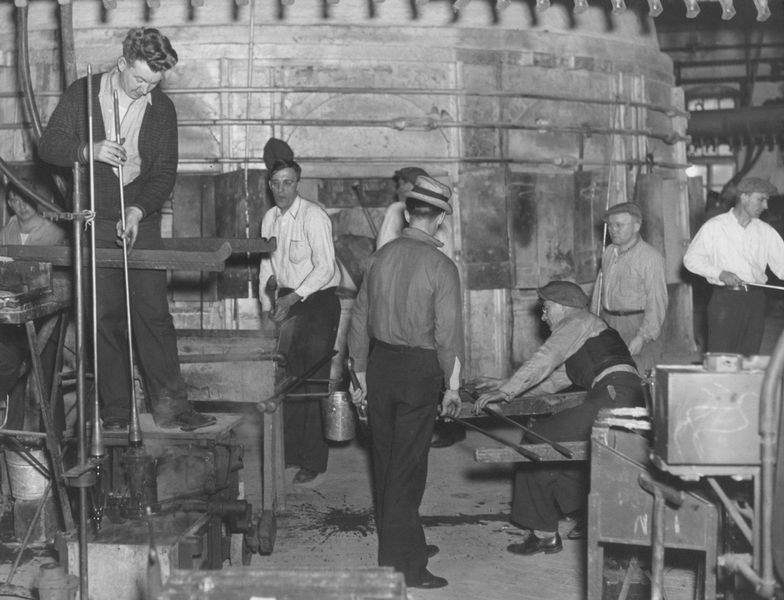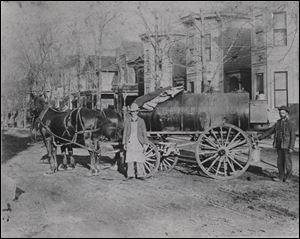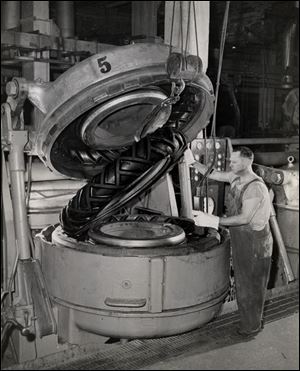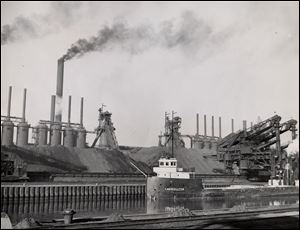
A tradition of industrial growth
3/2/2003
Workers man a furnace at Toledo's Libbey Glass in 1938 as Ohio climbed out of the Depression.
HO

Workers man a furnace at Toledo's Libbey Glass in 1938 as Ohio climbed out of the Depression.
When Ohio became a state 200 years ago, it was in the right place at the right time. As the young United States expanded west and opened new frontiers, Ohio was right in the middle of what was happening, and thousands of new residents pouring into the state found a lucrative combination of raw materials and a ready market for products.
Although the early industries seem primitive by today's standards, Ohioans were quick to grasp new manufacturing processes and new markets. At every juncture of industry, Ohio has been there with plants and workers to make the state an early leader in the manufacture of steel, automobiles and parts, airplanes, glass, petroleum products, machinery, rubber and plastics, and processed foods.
The end product is an industrial powerhouse: If Ohio were a separate nation, it would rank 23rd among the world's economies. Ohio is the leading producer of many products and ranks among the top five or top 10 in many other categories.
Commerce started slowly, even before statehood, but grew rapidly. By 1803, Cincinnati had a tannery, a pottery plant, flour mills, and businesses making saddles, firearms, hats, and clothing.

Horse-drawn wagons delivering petroleum products for Sun Oil were a common sight on the streets of Toledo in the late 19th century.
Industry developed in other parts of the state too. Within months of Ohio's statehood, a small smelting furnace started production in the region that eventually became Youngstown — making cast-iron kettles, stoves, and caldrons. By 1806, Cincinnati had a brewery (the first of many), and by 1814 it had a steam-powered grain mill and fabric-spinning factory.
Toledo didn't get its name or become a city until the 1830s, but long before that it had become a bustling Lake Erie port. And in 1833, the first railroad west of the Allegheny Mountains was started — the Erie & Kalamazoo. By the 1850s, railroads connected nearly every community in the state. Railroads in those days competed with canals that were built between 1825 and 1845: One connected Toledo and Lake Erie to the Ohio River at Cincinnati, and the other connected Cleveland to the Ohio River at Portsmouth. The heyday of the canals lasted only 50 years or so, even though some parts of the waterways operated until 1929.

A worker removes a heavy-duty tire from a curing mold at a Firestone plant in Akron, once the world's rubber capital.
Toledo became the leader in the glass industry, beginning with Edward Drummond Libbey's factory in 1888, followed by Edward Ford's plate-glass firm and Michael Owens' automatic bottle-blowing machine company. The predecessor of Owens-Illinois, Inc., was formed in 1903, and by 1929 was run by William Levis, who turned it into a global giant. Today, half of the world's glass containers are made by O-I and its affiliates or licensees.
For a time, Toledo was a leader in production of sailing ships, including some of the largest ever to sail the Great Lakes, and it was an early leader in automobile production. An estimated 12 million cars and trucks have been made in Toledo, including the current Jeep Wrangler and Liberty models.
Some of Ohio's cities carved out their own niches. Cleveland and Youngstown became major iron and steel producers. Refining was centered largely in Cleveland, Toledo, and Lima — for a time, John D. Rockefeller's Standard Oil trust in Cleveland had 90 percent of the refining and distribution market. Then, the U.S. Supreme Court broke it into 34 companies. Dayton had cash registers. Cincinnati had machine tools. Akron had tires and rubber and plastics.

An ore carrier sails up the Cuyahoga River past the Republic Steel Corp. plant in Cleveland in 1949.
Last year's Fortune 500 list included 28 Ohio corporations — with total sales of $384 billion — and the Fortune 1,000 included 56 firms headquartered in the state. Among the Fortune 500 are American Electric Power, the nation's largest power producer; Kroger Co., the largest grocery chain; Cardinal Health, Inc., the largest supplier of products and services to the health-care industry; Procter & Gamble, the largest maker of household and personal products; Goodyear Tire & Rubber Co., the largest maker of tires, and Findlay's Cooper Tire & Rubber Co., second largest U.S.-owned tire maker; Toledo's Owens Corning, the largest building-products manufacturer; four of the 10 largest automotive-parts makers, including Toledo's Dana Corp.; and two of the five largest metals companies.
Ohio ranks third among the states in value of manufactured goods, behind only California and Texas, according to the U.S. Census Bureau.
Ohio Department of Development reports put the state first in rubber and plastics production and primary metals; second in fabricated metals and motor vehicles and equipment; fourth in petroleum and coal; fifth in food processing; sixth in chemical manufacturing and aerospace and parts, and eighth in exporting.
Some of the largest plants of their type are in northwest Ohio — Clyde has the largest washing machine factory in the world; Campbell Soup's plant in Napoleon is the world's largest; the Heinz plant in Fremont makes more ketchup than any other plant in the world; and Dannon operates the planet's largest yogurt plant in Auglaize County. Ohio ranks first in things like power-driven hand tools, scales and balances, industrial trucks, and metal-forming machine tools. Its steel industry makes one-sixth of the nation's raw steel.
Ohio is pushing to provide a suitable environment for high-tech businesses. It remains to be seen whether the state is in the right place at the right time once again.